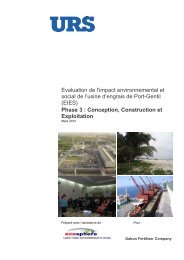En rapport avec le Réseau Interconnecté du Woleu-Ntem - Coface
En rapport avec le Réseau Interconnecté du Woleu-Ntem - Coface
En rapport avec le Réseau Interconnecté du Woleu-Ntem - Coface
You also want an ePaper? Increase the reach of your titles
YUMPU automatically turns print PDFs into web optimized ePapers that Google loves.
Les cultures :<br />
Sur l’axe Mitzic-Oyem, deux principa<strong>le</strong>s cultures ont été observées : <strong>le</strong>s<br />
plantations d’hévéa et <strong>le</strong>s cacaoyères.<br />
Tab<strong>le</strong>au 7: Localisation des cultures sur l'axe Mitzic-Oyem<br />
Types de culture<br />
Coordonnées<br />
Village<br />
Plantation d’hévéa 1 N 00°49.485'<br />
E011°32.951'<br />
Nkar<br />
Plantation d’hévéa 2 N 00°50.898'<br />
E011°33.968'<br />
Ayane<br />
Plantation d’hévéa 3 N 01°00.309'<br />
E011°38.553'<br />
Ngomessi<br />
Plantation d’hévéa 4 N 01°01.746'<br />
E011°33.342'<br />
Okala<br />
Cacaoyère 1 N 01°05.318'<br />
E011°41.814'<br />
Afia<br />
Section Oyem-Bitam :<br />
Cette section se caractérise par une pression anthropique plus importante<br />
que la section précédente. Le type de végétation rencontrée est celui des<br />
jeunes forêts secondaires à canopée ouverte et celui de vieil<strong>le</strong>s jachères.<br />
Tab<strong>le</strong>au 8: Quelques caractéristiques écologiques des transects réalisés sur l'axe<br />
Oyem-Bitam<br />
Transect Fermeture de la<br />
canopée (%)<br />
Sous bois Cordonnées<br />
7 30 Maranthaceae et Afromomon N 01°41.136’<br />
E<br />
8 20 Buissonnant N 01°49.530’<br />
E<br />
La végétation des transects :<br />
Transect 7 :<br />
Pterocarpus soyauxii (Papilionaceae), Distemonanthus benthamianus<br />
(Cesalpinaceae), Pycnanthus ango<strong>le</strong>nsis (Myristicaceae), Piptadeniastrum<br />
africanum, Pentac<strong>le</strong>thra macrophylla et Erythroph<strong>le</strong>um ivorense<br />
(Cesalpiniaceae), Petersianthus macrocarpus (Lecythidaceae),<br />
Hesteria parvifolia (Olacaceae), Alstonia boonei (Apocynaceae), Duboscia<br />
macrocarpa (Tiliaceae).<br />
67<br />
EIES – <strong>Réseau</strong> interconnecté <strong>du</strong> Wo<strong>le</strong>u‐<strong>Ntem</strong><br />
Rapport final Novembre 2010






